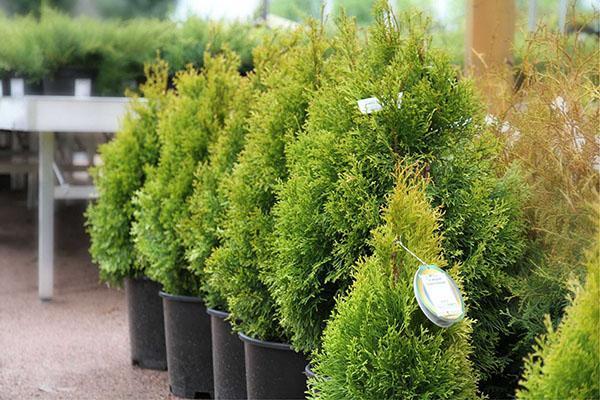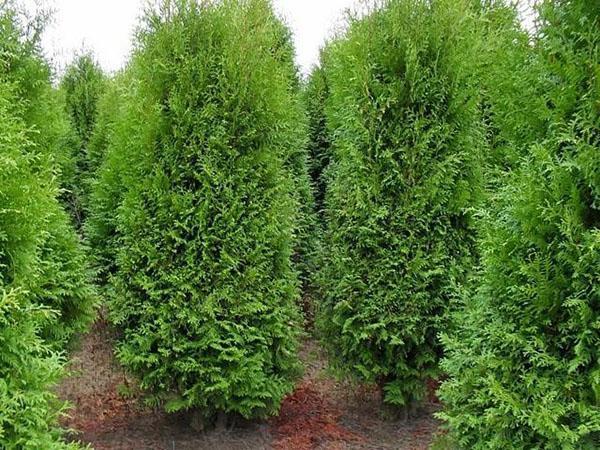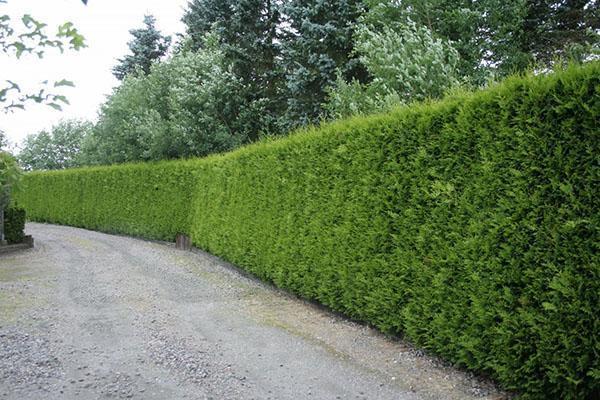Choosing the best varieties of thuja for a hedge on the site
 Evergreen thuja of different heights and shapes have long been actively used in landscape design. Thanks to the dense crown, the needles that persist throughout the year and sufficient unpretentiousness, the thuja hedge is one of the most popular uses of the plant.
Evergreen thuja of different heights and shapes have long been actively used in landscape design. Thanks to the dense crown, the needles that persist throughout the year and sufficient unpretentiousness, the thuja hedge is one of the most popular uses of the plant.
What varieties of thuja are best for a hedge
Planting evergreen shrubs along the border of the site will protect the territory not only from access of prying and immodest looks, but also gusts of wind, dust, polluted air from the road and even noise. On the site itself, the thuja will help to delimit the functional zones, the undersized varieties will become the basis for the borders. A perennial plant is universal, the main thing is to choose the right varieties and organize planting.
Which thuja are best for a hedge? The number of varieties of this evergreen today is in the tens. Climatic conditions in Russia are diverse. If in the southern regions gardeners can only focus on the decorative properties of thuja, then in the middle lane and to the north it is important to remember the frost resistance of the future hedge. Most often, for a living fence, the choice falls on two varieties: Brabant and Emerald.
Thuja Brabant hedge

For a hedge, thuja Brabant is an excellent choice. However, do not forget about the characteristic feature of the plant. Thuja needles do not remain green all year round. In winter, it takes on a brownish-brown hue, but does not crumble, maintaining the opacity of the hedge. In spring, early awakening shrubs can suffer from withering and sunburn.
 In the spring, after a haircut, the crown is actively restored. Usually coniferous crops used in landscape design do not give a large annual increase. However, there are exceptions. The Brabant variety is a fast-growing thuja for hedges, which grows up to 35 cm in height and 15 cm in width during the growing season.
In the spring, after a haircut, the crown is actively restored. Usually coniferous crops used in landscape design do not give a large annual increase. However, there are exceptions. The Brabant variety is a fast-growing thuja for hedges, which grows up to 35 cm in height and 15 cm in width during the growing season.
If large shrubs lack food or moisture, the thuja gradually loses its color brightness. One of the signs of nutritional deficiency is the appearance of numerous light brown bumps.
A thuja hedge of this variety is a solid wall that perfectly tolerates a haircut and retains its given shape. When planting evergreen shrubs, future growth is taken into account. An interval of 50 to 70 cm is made between the seedlings in the trench.
Maintenance pruning is done twice a year. In early spring, before the start of the awakening of growth points, the thuyu is cut for the first time, then the procedure is repeated in August. Usually thuja is chosen for planting at the age of 3-4 years. If you do not hesitate with pruning and treat it carefully, you can grow a living 2-meter wall no more than half a meter thick.
Thuja Smaragd hedge
 Tui of various varieties differ not only in appearance. The Smaragd variety (T. occidentalis Smaragd) is no less popular than Brabant. This is the same large plant, up to 4–5 meters high, but with a conical crown and needles that never lose their green tint.
Tui of various varieties differ not only in appearance. The Smaragd variety (T. occidentalis Smaragd) is no less popular than Brabant. This is the same large plant, up to 4–5 meters high, but with a conical crown and needles that never lose their green tint.
A rare feature for thuja makes the variety popular not only as a tool for a hedge. A splendid shrub that is rarely withering in winter:
- grows very slowly;
- does not require frequent haircuts;
- looks great both as part of a live wall and solo.
Bottom part hedge from thuja, Smaragd has a high density, rich green color and, with minimal pruning, keeps a flat surface. Due to the natural conical shape of the crown, the top of the hedge retains its natural shape. This feature is very useful when it comes to hedges at the border of the site. The jagged edge is more difficult to overcome for both humans and animals.
 Before planting thuja for a hedge, dig a trench about 50-60 cm wide and deep. The density of the green fence depends on the spacing between the bushes. The average landing gap is half a meter.
Before planting thuja for a hedge, dig a trench about 50-60 cm wide and deep. The density of the green fence depends on the spacing between the bushes. The average landing gap is half a meter.
It is good if the thuja seedlings have a closed root system. In this case, they easily take root, and hedges from them can be planted not only in spring.
For thuja hedges, sufficient nutrition and regular watering are important. Drought makes the needles turn pale, the already slow growth stops, the young shoots dry out. Plants do not tolerate stagnant moisture and the proximity of groundwater. Therefore, in the risk zone in the planting trench, it is useful to make a drainage layer about 20 cm thick.
Thuja varieties for hedges
 The selection is not limited to the plants described above. An equally impressive wall of greenery can be created by planting thuja Columna along the border of the site. A perennial plant up to 7 meters high with a dense cylindrical crown with a diameter of up to 130 cm. Like Smaragd, the shrub does not change the color of the needles, but it has a high growth rate and increases in size by 20 cm per year.
The selection is not limited to the plants described above. An equally impressive wall of greenery can be created by planting thuja Columna along the border of the site. A perennial plant up to 7 meters high with a dense cylindrical crown with a diameter of up to 130 cm. Like Smaragd, the shrub does not change the color of the needles, but it has a high growth rate and increases in size by 20 cm per year.
Thuja Holmstrup, up to three meters high, has a unique crown, which from the side seems curly or corrugated. A dense column about a meter in diameter tolerates winter cold well, is unpretentious and does not change color throughout the year. To a beginner's question: "Which thuja is better for a hedge?", You can safely point to this variety. A plant with a small annual growth costs a haircut once every two years.
Canadian thuja varieties Sankist has a height of 3 to 5 meters. The crown in the form of a wide cone with a diameter of 1–2 meters stands out due to the beautiful color of the golden needles, which turn brownish-bronze for the winter.
 What varieties of thuja are best for low hedges? The choice of plants for creating borders is quite large. Species with a naturally compact crown, more winter-hardy than tall plants, and do not need frequent labor-intensive pruning, are especially popular. An example is thuja Danica no more than 60 cm in height.
What varieties of thuja are best for low hedges? The choice of plants for creating borders is quite large. Species with a naturally compact crown, more winter-hardy than tall plants, and do not need frequent labor-intensive pruning, are especially popular. An example is thuja Danica no more than 60 cm in height.